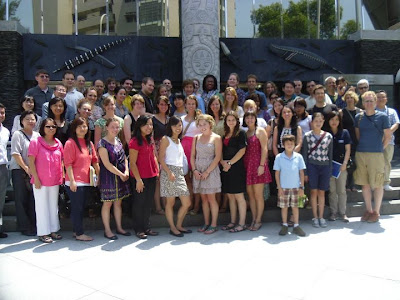Last weekend I headed up to Taipei to attend the Fulbright Taiwan orientation/welcome activities. I technically already attended an orientation in DC back in July but that one was for ETAs only so I was pretty excited to meet all the other Taiwan grantees (not to mention rubbing elbows with all the political big wigs from the American Institute in Taiwan or AIT, which is basically the unofficial Taiwanese version of an embassy). Also, getting a free trip to Taipei was a definite plus.
 |
| Arriving in style with my Yilan homegirls |
 |
| William A. Stanton, the director of AIT (basically the American Ambassador to Taiwan except that Taiwan is not officially allowed to have ambassadors) |
 |
| The whole Fulbright group outside the Aboriginal Museum |
 |
| Fancy lunch |
 |
| The National Palace Museum |
Quick history lesson: Most of the pieces currently in the museum were collected by China's ancient emperors over the last 8,000 years or so but, after the last emperor was dethroned in 1925, the collection fell into the hands of the new Nationalist Government under Chiang Kai-sheck. When the Japanese invaded in the 1930s, the government ordered the most valuable pieces to be taken out of Beijing and hidden to keep them from the Imperial Japanese Army. Then, after WWII was over and the Japanese had left, the Chinese civil war broke out between Chiang Kai-sheck's Nationalists and Mao Zedong's Communists. As the fighting grew worse, the directors of the Palace Museum in Beijing decided to send some of the most important pieces in the collection to Taiwan for safekeeping. In the end, the National Palace Museum wound up with about a quarter of the original collection. In the end, this turned out to be a very good thing because much of what was left in China was destroyed in the during Mao's Cultural Revolution between 1966 and 1976. Today, there is still some debate surrounding the museum and it's collection. While the Chinese government argues that the collection was stolen and that it legitimately belongs in China, Taiwan defends the collection as a necessary act to protect the pieces from destruction, especially during the Cultural Revolution.
Okay, that's enough history for now. The point is, the museum is super interesting (especially if you're a history nerd like me) and it's collection is phenomenal. Unfortunately, there is no photography allowed in the museum but, if you're interested, you should check out the museum website by clicking here. You can take a look at the exhibits or a virtual tour of the museum. Fun stuff!
After we left the museum, I decided to help a fellow Fulbrighter out with her project. Brenda Zlamany is an artist and a Fulbright senior scholar. For more on her art, you can visit her website at http://brendazlamany.com/. Her current project is about "the Face of Taiwan." She's painting 888 (8 is a lucky number in Asia) watercolor portraits of people in Taiwan with a special emphasis on aboriginal areas and people.
 |
| Brenda's notebooks of paintings. She's completed about 650 so far. |
 |
| Brenda's portrait of Vivian, one of Fulbright Taiwan's many awesome staff members. She's pretty great. |
So we headed back to the Taipei Artist Village with Brenda and she painted me and 8 or 9 other volunteers on Saturday night.
 |
| Hard at work |


1st off: I love the dress you are wearing in the first pic, very pretty.
ReplyDeleteSecondly: I think the portrait looks like you, that is really cool. I like that you have one raised eyebrow ;)
3rd off: glad you got some cheese!!!
Love you seester.
Agree with Jess on the first dress...like this one too, but that one was super cool. The pic does resemble you, but you're much prettier!
ReplyDeleteLoving the history inserts and the braggin'--yes, we want to know all!!!
So glad you're having this incredible experience and the family gets to come and join you! Awesome! Sure wish I had time and money to come too!